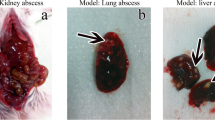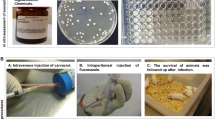Abstract
Objective
To evaluate the effect and safety of cinnamaldehyde on immunosuppressed mice with invasive pulmonary candidiasis.
Methods
An immunosuppressed BALB/c mouse model was established by intraperitoneal administration of cyclophosphamide (200 mg/kg) once daily for 2 days. The immunosuppressed mouse with invasive pulmonary candidiasis model was further established by nasal perfusion of Candida albicans suspension. In the cinnamaldehyde treatment group, immunosuppressed mice with invasive pulmonary candidiasis were orally given cinnamaldehyde 240 mg/(kg·d) for 14 consecutive days. Fluconazole and 0.9% saline were used as the positive and negative controls, respectively. The mice in the cinnamaldehyde safety evaluation group were orally administered cinnamaldehyde 480 mg/(kg·d) for 42 days to observe the safety of the drug. Microscopic identification, fungal culture, histopathological examination, and (1,3)-beta-D-glucans detection were conducted to analyze the effect of cinnamaldehyde on C. albicans.
Results
The fungal clearance rate in the cinnamaldehyde treatment group was higher than that in the fluconazole control group (80.00% vs. 56.67%, P<0.05). The level of (1,3)-β-D-glucan in the cinnamaldehyde treatment group was lower than that in the fluconazole positive control group (1160.62 ±89.65 pg/mL vs. 4285.87 ± 215.62 pg/mL, P<0.05). The survival rate of mice in the cinnamaldehyde safety evaluation group was 100%, and no significant pathological changes of kidney, lung and liver were observed.
Conclusions
Cinnamaldehyde was effective and safe in treating immunosuppressed BALB/c mice with invasive pulmonary candidiasis. It would be a potentially novel drug for anti-candidiasis infection.
Similar content being viewed by others
References
Balaguer MP, Lopez-Carballo G, Catala R, Gavara R, Hernandez-Munoz P. Antifungal properties of gliadin films incorporating cinnamaldehyde and application in active food packaging of bread and cheese spread foodstuffs. Int J Food Microbiol 2013;166:369–377.
Kocevski D, Du MY, Kan JQ, Jing CJ, Lačanin I, Pavlović H. Antifungal effect of Allium tuberosum, Cinnamomum cassia, and Pogostemon cablin essential oils and their components against population of aspergillus species. J Food Sci 2013;78:M731–M737.
Li HB, Shen QS, Zhou W, Mo HZ, Pan DD, Hu LB. Nanocapsular dispersion of cinnamaldehyde for enhanced inhibitory activity against aflatoxin production by Aspergillus flavus. Molecules 2015;20:6022–6032.
Sharma J, Gairola S, Sharma YP, Gaur RD. Ethnomedicinal plants used to treat skin diseases by Tharu community of district Udham Singh Nagar, Uttarakhand, India. Ethnopharmacology 2014;158:104–206.
Yang F, Ding S, Liu W, Liu J, Zhang W, Zhao Q, et al. Antifungal activity of 40 TCMs used individually and in combination for treatment of superficial fungal infections. J Ethnopharmacol 2015;163:88–93.
Masevhe NA, Mc Gaw LJ, Eloff JN. The traditional use of plants to manage candidiasis and related infections in Venda, South Africa. J Ethnopharmacol 2015;168:364–372.
Deng JH, Wang GS, Ma YH. Study on anti-candida effect of 32 Chinese herbal extracts. World Chin J Digestol (Chin) 2010;18:741–743.
Wang GS, Deng JH, Ma YH. Experiments on effects of three botanicals on bioactivity of Aspergillus niger. Chin Arch Tradit Chin Med (Chin) 2013;10:2273–2274.
Wang GS, Deng JH, Jiang SH. Chinese medicine extraction group and the object of Candida, Aspergillus in vitro antibacterial test. Lishizhen Med Mater Med Res (Chin) 2010;21:884–885.
Ma YH, Deng JH, Wang GS. Therapeutic effect of cinnamon oil in mice with pulmonary Candida albicans infection. World Chin J Digestol (Chin) 2009;17:1545–1547.
Chen HL, Gong LZ, Guo JW, Huang YZ, Chen XP, Zhao DF, et al. Establishment of invasive pulmonary aspergillosis model in mice. Chin J Exp Clin Infect Dis (Chin) 2013;3:9–12.
Li F, Cao B, Qu JX, Shen H, Liu ZJ, Wang P. Experimental study on animal model of invasive pulmonary aspergillosis in mice. Chin J Clin (Chin) 2015;9:107–110.
Wang GS, Deng JH, Ma YH. Mechanisms, clinically curative effects, and antifungal activities of cinnamon oil and pogostemon oil complex against three species of Candida. J Tradit Chin Med (Chin) 2012;32:19–24.
Naveed R, Hussain I, Tawab A, Tariq M, Rahman M, Hameed S, et al. Antimicrobial activity of the bioactive components of essential oils from Pakistani spices against Salmonella and other multi-drug resistant bacteria. BMC Complement AIlternat Med 2013;13:265–268.
Xing FG, Hua HJ, Selvaraj JN, Zhao YJ, Zhou L, Liu X, et al. Growth inhibition and morphological alterations of Fusarium verticillioides by cinnamon oil and cinnamaldehyde. Food Control (Chin) 2014;46:343–350.
Graybill JR, Najva LK, Montalbo EM, Barchiesi FJ, Luther MF, Rinaldi MG. Treatment of histoplasmosis with MK-991(L-743,872). Antimicrob Agents Chemother 1998;42:151–153.
Jiang QF, Zhou YJ, Sheng CQ, Wang JZ. Research progress on antifungal agents acting on fungal cell walls. Chin Pharm J (Chin) 2003;38:410–413.
Xie XM, Zhang WP, Fu YY, Xu Y. Study on the mechanism of action of cinnamaldehyde and citral against Aspergillus. J Chin Tradit Herb Drugs (Chin) 2004;35:430–432.
Wang K, Xu Z, Wang WQ, Zhu YH, Cui ZF. Mechanism of cinnamaldehyde-specific inhibition of yeast cell wall synthesis. Food Ferment Industr (Chin) 2012;38:68–71.
Huang J, Meng S, Hong S, Lin X, Jin W, Dong C. IL-17C is required for lethal inflammation during systemic fungal infection. Cell Mol Immunol (Chin) 2016;13:474–483.
Karageorgopoulos DE, Qu JM, Korbila IP, Zhu YG, Vasileiou VA, Falagas ME. Accuracy of β-D-glucan for the diagnosis of Pneumocystis jirovecii pneumonia: a meta-analysis. Clin Microbial Infect 2013;19:39–49.
Author information
Authors and Affiliations
Contributions
Wang GS conceived and supervised the study; Li JH and Deng JH designed the experiments; Li JH, Deng JH and Zhao YL performed the experiments; Wang GS analyzed the data and wrote the manuscript. All authors listed have read the complete manuscript and have approved submission of the paper.
Corresponding author
Ethics declarations
There was no conflict of interest.
Additional information
Supported by the Natural Science Foundation of Hebei Province (No. H2013206316)
Rights and permissions
About this article
Cite this article
Deng, Jh., Li, Jh., Zhao, Yl. et al. Effect and Safety of Cinnamaldehyde on Immunosuppressed Mice with Invasive Pulmonary Candidiasis. Chin. J. Integr. Med. 27, 286–290 (2021). https://doi.org/10.1007/s11655-020-3075-x
Accepted:
Published:
Issue Date:
DOI: https://doi.org/10.1007/s11655-020-3075-x




